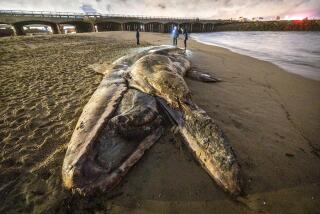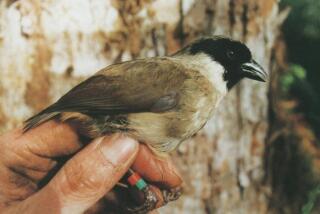Important Food Source for Fish Disappearing From Great Lakes
- Share via
CHICAGO — A primary source of food for young fish is quickly disappearing from the Great Lakes, according to scientists who fear it could jeopardize decades of progress in restoring fish populations.
Diporeia, half-inch-long shrimp-like crustaceans, have vanished from Lake Erie and are declining at alarming rates in lakes Michigan, Ontario and Huron--a phenomenon scientists suspect is linked to zebra mussels, a Black Sea native that arrived in this country in the late 1980s.
“It’s one of those issues that is just so scary because . . . we have seen such recovery [of fish species] in the 30 years since the Clean Water Act was passed,” said John Gannon, science coordinator at the U.S. Geological Survey’s Great Lakes Science Center in Ann Arbor, Mich. “We had this wonderful success story running, and then one of the main food sources starts to disappear.”
The demise of diporeia could have dire consequences for many types of fish, scientists said. Many fish that eat diporeia in turn are eaten by larger fish such as salmon and lake trout. The problem has not affected such sport fish, but whitefish, which are commercially harvested, have suffered.
Exactly what is causing the disappearance of diporeia, which live on lake bottoms, remains a mystery.
One theory is that zebra mussels, thumbnail-sized mollusks that arrived in the ballast water of oceangoing ships, are competing with diporeia for the same food--and winning, said Marc Tuchman, an environmental scientist in the Environmental Protection Agency’s Great Lakes National Program Office in Chicago. Both dine on bacteria and algae, but the mussels multiply rapidly and can filter vast amounts of water.
There also is speculation that there is enough food but mussels are extracting from it a nutrient essential to diporeia, that mussels introduced a pathogen lethal to diporeia, or that a mucus-like substance excreted by mussels is killing diporeia, said Thomas Nalepa, a research biologist at the Great Lakes Environmental Research Lab in Ann Arbor. The lab is part of the National Oceanographic and Atmospheric Administration.
Researchers have found no diporeia in Lake Erie since the early 1990s, and Tuchman said fisheries experts have reported a dramatic decline in rainbow smelt and young whitefish there. Diporeia levels have also collapsed in Lake Ontario and are disappearing from the shallow waters of southern Lake Michigan.
Their numbers have declined in Lake Huron but have not disappeared in any locations there yet, Tuchman said. In colder Lake Superior, where there are few zebra mussels, diporeia continue to thrive.
In the last few years, diporeia also have begun disappearing from the deeper waters of northern Lake Michigan. In waters off Manistique, in Michigan’s Upper Peninsula, for example, researchers found 10,000 diporeia per square meter in 1997, but none in 2000.
Gannon said that is particularly alarming because whitefish, which feed on diporeia and are important commercially, have made a phenomenal recovery in the upper Great Lakes in the last 15 years.
Fish may develop a taste for other food, such as mysis, a shrimp-like organism similar to diporeia. But that could put a strain on mysis populations, researchers said. The EPA plans to monitor mysis and other fish food.
In areas of Lake Michigan where diporeia disappeared, whitefish even began eating zebra mussels, which weren’t very healthy for them, Nalepa said. He said the fish, whose guts became packed with shell material, were so skinny that fishermen could no longer get a fillet off them.
The diporeia decline has not yet affected sport fish such as trout and salmon because their food--including alewives and smelt--still are finding alternatives to diporeia, researchers said.
But the lack of diversity--especially if bottom-feeding fish begin to decline--eventually could affect popular species, they said.
“The fish that are affected now are not glamorous fish like trout or salmon,” said Randy Owens, a fishery biologist studying Lake Ontario for the U.S. Geological Survey in Oswego, N.Y. “It’s just that, from a scientific standpoint, we will have a big void in the whole food web out here.
“We would be getting down to a system where we’re just depending on a few fish to keep things going, instead of a wide variety of fish,” he said. “If something happens to the alewives and smelt, then it’s crunch time on trout and salmon.”
Scientists say they fear the diporeia disappearance is just beginning, and say the area in which they are declining expands every year.
“It may be slow or it may be fast, but a decline is occurring, and we will see more and more impacts on fish,” Nalepa said.
He said he believes the decline of diporeia is related to zebra mussels, although he’s not sure how and, in some cases, there is no obvious connection. In St. Joseph, Mich., where diporeia disappeared within six months in 1992, researchers had never found a zebra mussel, he said.
But most disturbing is that there doesn’t appear to be any way to stop the disappearance, Tuchman said.
“Unfortunately, all we can do is keep an eye on it, monitor it, note the decline and hope it reverses,” he said. “There is nothing we can do.”






